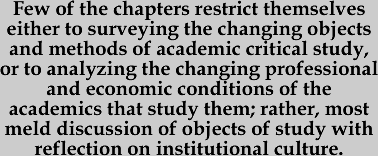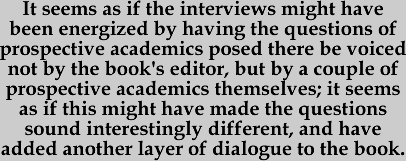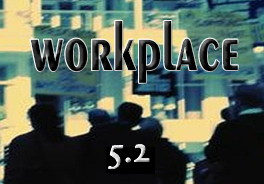![]()
Professions: Conversations
on the Future
of Literary and Cultural Studies
edited by Donald E. Hall
University of Illinois Press, 2001
Dana Carluccio
1.
Despite the suggestive title reference to the "future" of literary
and cultural studies, there is little that’s dire or proclamatory in Professions,
one of the latest entries in the genre of academics analyzing academia.
Donald Hall’s introduction suggests one reason this might be true: in
an effort to provide a kind of handbook for graduate students who seek
information about challenges facing literary and cultural critics, the
book was undertaken in a format that would "demonstrate . . . a genuine
respect for divergent opinions and diverse practices" (2). The book
finds this format in a series of conversations between pairs of practicing—and
politely differing—academics, rather than singly authored pronouncements. Thus,
the conversational model does seem to spur the collection’s participants
to formulate their positions with some degree of perspective—and also
makes those formulations both technically informed and colloquially expressed, rendering their stakes more accessible and their appeal more
engaging and cogent. However, this model seems to alter the substance
of the entries, as well. The most palpable substantive effect of
the book’s format is the clarity of the participants’ investments in their
dialogues. The contributors’ senses of their own positions in debate
produce hesitancies, contradictions, and frank admissions that often extend
and nuance their argumentative positions. Such frankness, for example,
surfaces in one critic’s self-conscious declaration that he remains committed
to the notion of literary instruction as a moral exercise, another’s of
having decided to go to graduate school because she liked to read, and
another’s of his purported faith in the capacity of high theory to save
the profession from its "proletarianization" (187). In
its consequent sense of personal stakes, the book as a whole offers less
a snapshot of the "state of the profession" than a topography
of professional investments and expectations. Not all of these investments
and expectations will earn sympathy from all readers, but they do all
energize the collection, multiplying loose ends rather than tidying them
up—and laying out fields of possible response.
expressed, rendering their stakes more accessible and their appeal more
engaging and cogent. However, this model seems to alter the substance
of the entries, as well. The most palpable substantive effect of
the book’s format is the clarity of the participants’ investments in their
dialogues. The contributors’ senses of their own positions in debate
produce hesitancies, contradictions, and frank admissions that often extend
and nuance their argumentative positions. Such frankness, for example,
surfaces in one critic’s self-conscious declaration that he remains committed
to the notion of literary instruction as a moral exercise, another’s of
having decided to go to graduate school because she liked to read, and
another’s of his purported faith in the capacity of high theory to save
the profession from its "proletarianization" (187). In
its consequent sense of personal stakes, the book as a whole offers less
a snapshot of the "state of the profession" than a topography
of professional investments and expectations. Not all of these investments
and expectations will earn sympathy from all readers, but they do all
energize the collection, multiplying loose ends rather than tidying them
up—and laying out fields of possible response.
2. The collection organizes itself into three broad sections, titled "Changing Paradigms," "Changing Applications," and "A Changing Profession." The first section focuses roughly on professional values, reflected as they are in institutional forms. The second section discusses particular fields of literary and cultural study (poetics, African American studies, and Lesbian and Gay studies). The final section, which departs from the first two in comprising a series of interviews and a self-titled "rant," treats the status of professional practice in the realms of academic publishing, the use of theory, and continued changes to academic hiring. Though all but one chapter offers a kind of discussion amongst at least two professional critics, then, the precise formula of discussion ranges from actual dialogues conducted in turn-taking exchanges, to co-authored essays, to single-person interviews. In keeping with these changing formulas, the individual chapters do not generally endeavor to refer or respond to each other, either. In this way, the book works as a kind of dictionary of issues that can be consulted at any point.
3. Whatever issues the individual chapters explore, though, they all tend to evince a doubled focus that distinguishes the book from many other explorations of the critical professions (and while the contributors are disproportionately composed of English professors, we do encounter some comparative literature specialists, women’s studies professors, and even a French professor and a historian). Few of the chapters restrict themselves either to surveying the changing objects and methods of academic critical study, or to analyzing the changing professional and economic conditions of the academics that study them; rather, most meld discussion of objects of study with reflection on institutional culture. This is most obvious in a chapter titled "Star Search," which analogizes the American media’s focus on celebrity queer figures to the academic star system’s "totemized figures of gay and lesbian studies" (146). This double focus might be viewed as the particular way that this collection explores a familiar problematic: the relationship between academic work, on the one hand, and academics’ relationships to the various audiences of that work—invoked in this book as those who control state budgets, publish books, and pay tuition—on the other. However, while lurking behind this problematic is an awareness of the altered social roles of higher education and the critical professions, the collection tends not to bemoan such alterations, considering rather the places where crises generate unintended (and perhaps arguably) positive consequences. The book is refreshing in its regard for such places—among which Bonnie Zimmerman numbers the increasing necessity, in a budget crisis, for cross-disciplinary work, for "cooperat[ion] and collaborat[ion]" (259); and Susan Lanser counts the likelihood of decreasing academic job prospects to forge connections between academia and other occupations. In this regard, too, the collection provocatively reformulates the factors involved in a decision to complete a Ph.D. program, and makes an excellent reference for graduate students in the critical professions.
4. Despite
the entry-like format of the book’s chapters, they also tend to return
to two related features of the changing status of the critical professions:
the increasing production of critical experts (and the narrowness expertise
entails), and the relationship of critical expertise to pedagogy. The
book implicitly suggests that these two concerns are intimately connected—in
deciding to tackle the perceived problem of academic communication by
writing a book intended to serve as instruction for graduate students,
Hall’s project posits some relationship between the state of the (increasingly
narrow) profession and the state of pedagogy. This relationship may
be part of what he refers to, in fact, when he suggests that the book
"puts into print form" Gerald Graff’s notion of "teaching
the conflicts" (3). Perhaps appropriately, then, the entry that
voices this relationship between the state of the profession and the state
of pedagogy most explicitly is an exchange between Graff and Jane Tompkins,
titled "Can We Talk?" This chapter examines the status
of dialogue between members of the critical professions, and in keeping
with Graff’s other work, he suggests in it that "the place to begin
creating intellectual community on campus is the place to which so much
of our energy is necessarily devoted—the curriculum itself" (23). This
focus on pedagogy recurs in John McGowan and Regina Gagnier’s discussion
of "intellectual work today," which explores the relationship
of public intellectualism to the training of literary scholars (and somewhat
anxiously explores their disconnection, as well), and in James
Phelan and James Kincaid’s debate about "what we owe texts,"
which examines how the ways that reading "texts" versus "discourse"
informs (or again, doesn’t inform) the curriculum and the profession. This
continued, if not always foregrounded, focus on pedagogy frequently displays
a kind of anxiety or uncertainty: Donald Hall’s introduction hypothesizes
that professionals’ "concentrat[ing] only on disagreements . . .
does a grave disservice to professionals-in-training" (5), while
John McGowan wonders aloud how his academic research has much of anything
to do with the instruction he provides graduate students. On the
other hand, multiple entries display anxiety about focusing on
teaching, with Geoffrey Harpham parodying such concern as a misconception
of scholarship and pedagogy as "identical activities" (198),
and Bonnie Zimmerman summarizing changes to the critical professions in
a kind of move from classical to vocational training. In many ways,
then—and in keeping with the book’s overall project—the entries in Professions
take pedagogy as a metaphor for their critical investments. Indeed,
the book’s introduction literalizes this metaphor in suggesting that professional
success is, in fact, a kind of pedagogic success—is the ability of professionals
to "learn from each other" (7). The conversations on disciplines
also foreground this metaphor, in their focus on disciplines that address
particular constituents,  organized
by identity. In this way, the book is a thought-provoking read about
literary and cultural "studies" in the pedantic as well as disciplinary
sense (though Hall notes the ambiguity of the word "professions"
in the title, this ambiguity is unremarked, suggesting its implicit pervasion
of the text).
organized
by identity. In this way, the book is a thought-provoking read about
literary and cultural "studies" in the pedantic as well as disciplinary
sense (though Hall notes the ambiguity of the word "professions"
in the title, this ambiguity is unremarked, suggesting its implicit pervasion
of the text).
5. Perhaps because of anxieties about teaching, though, the collection rarely seems to foreground it as one of the points it is interested to identify at which changes to the nature of the academy, and the academic professional, can be explored as a strength. That is, since most of the participants in academia teach, at some point, whether as professors, non-tenure-track lecturers, or graduate instructors, the book’s return to pedagogy seems to suggest a place particularly ripe for dialogue on the changing status of the critical professions. In fact, though, at the point where the book most explicitly engages the concerns of non-tenured and graduate student participants in academia—the book’s last section, which seeks explicitly to address proposed questions from potential job applicants about the availability of academic jobs, the qualifications currently employed professors seek, and the employment opportunities available outside of academia—the book's dialogic form seems to fall slightly flat in two ways. First, this final section is conducted in interview format, which, while it has the advantage of providing direct communication to readers, also solidifies that communication somewhat. That is, while this format does arrange disagreements side by side, it consequently doesn’t force them to engage with and modify each other. This seems to result fleetingly in more complacency and less self-awareness than in other parts of the book. For example, Regina Gagnier’s early critical take on the way "the economy" is reified in American political conversations is left behind precisely by such reifications in the final chapter’s discussion of changes to departmental budgets. While this might be a feature of the focus of the last portion of the book, which aims more explicitly to provide advice to prospective academics rather than to sort through the values and positions of those already working in critical fields, this difference gets at a second way in which the book becomes less dialogic at this point, too. It seems as if the interviews might have been energized by having the questions of prospective academics posed there be voiced not by the book’s editor, but by a couple of prospective academics themselves; it seems as if this might have made the questions sound interestingly different, and have added another layer of dialogue to the book. To its credit, the book does seek to represent, in its contributors, multiple kinds of academic positions—not all of its participants are from research universities, nor are all of them from Ph.D.-granting institutions, and this enables a kind of honesty and perspective that would not have otherwise been achieved (for example, in Donald Hall’s direct discussion of how he completes such book projects "'under' a 4/4 teaching load" [221]) . If the book could have used more perspectives, then, that is perhaps largely to say that the collection succeeds in modeling a particular kind of conversation, and posing particular kinds of challenges. For this success, the book deserves the breadth of readership, and the level of response, that would make it the touchstone of debate its editor hopes it will become.
